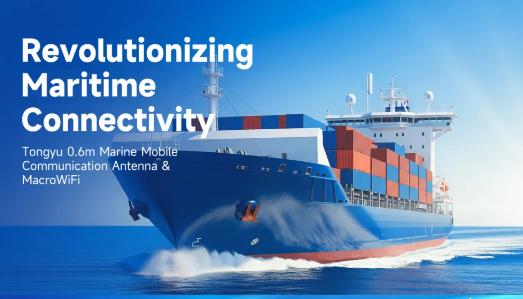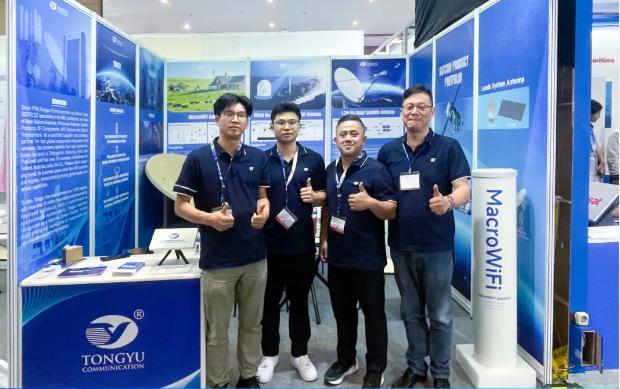The highly anticipated International Maritime Exhibition (INAMARINE 2025) successfully concluded from July 29th to 31st, 2025. At this industry grand event, Tongyu Communication made a powerful debut, attracting widespread attention with its "Satellite-Ship-Terminal" one-stop, full-stack solution for marine intelligent communication and our four core products. We exhibited our professional solutions for the maritime communication sector, guiding it toward a broader prospect of development.


Overview of INAMARINE 2025
INAMARINE is one of the most important shipbuilding and maritime exhibitions in Indonesia, held annually in Jakarta. It showcases a wide range of maritime products and services, including ship engines, accessories, paints, navigation, and maritime communication equipment.
INAMARINE 2025 solidified its position as a premier international platform for the maritime and shipping industries, spanning 16,000 square meters, gathering 500 exhibitors, and attracting approximately 20,000 professional visitors.
Exhibitors leveraged this prime opportunity to display their products and services. Furthermore, the accompanying high-level seminars and networking events offered invaluable opportunities for learning and business collaboration within the industry.
Status of the Maritime Communication Industry
The maritime communication industry is experiencing unprecedented growth, driven by the global demand for connectivity, operational efficiency, and safety at sea.
1. Market Size and Growth Trends
The global maritime satellite communication market is indeed on a robust upward trajectory. According to Future Market Insights[1], the market, valued at around USD 6.9 billion in 2025, is on a trajectory to reach USD 15.7 billion by 2035, rising at a CAGR of 8.5%. This expansion is fueled by the increasing need for high-speed internet for crew welfare, the adoption of IoT and big data for smart shipping, and stringent regulatory requirements for enhanced security and safety[2].
2. Technological Development Trends
The evolution of offshore maritime communication is characterized by rapid technological advancements, reshaping connectivity on the high seas.
(1) Maritime Satellite Communication Technology
- LEO Constellations: The deployment of massive LEO constellations is a game-changer, offering latency comparable to terrestrial networks. This enables real-time applications like remote vessel monitoring, video conferencing, and telemedicine, previously impractical with traditional GEO satellites.
- Multi-orbit Satellite Systems: Solutions that seamlessly integrate GEO, MEO, and LEO satellites are becoming the standard. This hybrid approach ensures reliable, continuous, and low-latency coverage globally, automatically selecting the best available signal.
- High Throughput Satellites (HTS): HTS technology, utilizing spot beam architecture, provides significantly higher bandwidth and lower cost-per-bit. This is crucial for delivering affordable, high-speed broadband services to vessels of all sizes.
(2) 5G Technology Integration
The integration of 5G technology in coastal areas and ports is creating powerful sea-land communication networks. 5G's ultra-low latency and high capacity facilitate rapid data transfer during port calls, enable autonomous vessel operations in controlled areas, and support advanced augmented reality for maintenance and training.
(3) Cybersecurity
As maritime operations become more connected, the attack surface for cyber threats expands exponentially. Cybersecurity has thus become a top priority. The industry is focusing on developing robust, multi-layered security protocols for communication links, onboard networks, and operational technology (OT) systems to protect against hacking, data breaches, and ransomware attacks.
Star product of Tongyu
1. 0.6m Marine Mobile Communication Antenna
The 0.6m Marine Mobile Communication Antenna, with its compact and lightweight structure, is an ideal choice for small vessels with limited space. It not only saves space but also achieves exceptional satellite signal tracking performance through a stable platform and patented technology. This enables small vessels to easily conduct various network applications such as video conferencing and IP telephony at sea, bringing new vitality to maritime communication systems.
2. 1.2m Ku-band Satellite Antenna
The 1.2m Ku-band Satellite Antenna demonstrates strong adaptability across multiple scenarios, excelling in applications such as port fixed communications and offshore mobile platform communications.
It delivers high-speed, stable transmission performance, robustly supporting HD video streaming, large-scale data backhaul, and satellite internet connectivity.
Integrated with an outdoor unit and BUC, and compatible with mainstream modems, this antenna is easy to install and debug.
Boasting exceptional anti-interference and wind-resistant capabilities, it maintains stable operation even under extreme temperatures and harsh weather conditions, ensuring absolute reliability for maritime communication links.
3. Ka-Band Portable Terminal Antenna
The Ka-Band Portable Terminal Antenna incorporates low-profile antenna technology, multi-functional chips, and highly integrated channel solutions, successfully condensing the functionality of a Ka-band satellite communication terminal into a lightweight device. With its small size, light weight, low power consumption, and ease of installation and portability, it showcases unprecedented convenience for personal satellite communications for offshore personnel.
4. Macro WIFI
MacroWiFi can serve as the wireless network hub for the entire vessel. Through its high-gain antenna array and 180° wide-angle coverage design, it achieves signal coverage far beyond that of ordinary devices and stably supports a large number of concurrent users. Its convenient power supply method and efficient cloud management platform further enhance its practical value for operation and maintenance.
More importantly, MacroWiFi can seamlessly collaborate with the aforementioned shipborne satellite antennas. When a vessel establishes a satellite link via the antenna, MacroWiFi instantly converts it into a wireless network that blankets the entire vessel—from bow to stern, from deck to cabin—completely eliminating traditional WiFi dead zones.


Conclusion
The future of the ocean is a future of seamless connectivity, with each technological leap reshaping the landscape of maritime communication. In this dynamic landscape, our comprehensive suite of products is uniquely positioned to play a pivotal role in bringing this connected future to life.
We sincerely invite you to contact our experts to discover how our end-to-end solutions can help your fleet or business achieve more efficient, safer, and smarter operations. Together, let's pioneer a connected future for the maritime communication industry.
Reference
[1]. Available at:
https://www.futuremarketinsights.com/reports/maritime-satellite-communication-market
[2]. Available at:
https://www.mordorintelligence.com/industry-reports/maritime-satellite-communication-market

